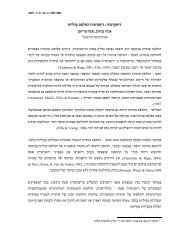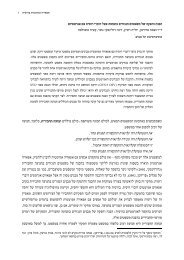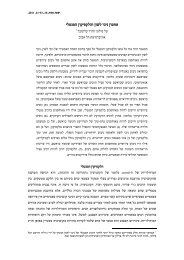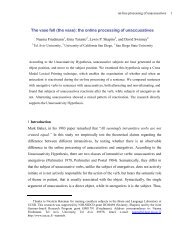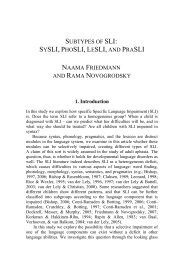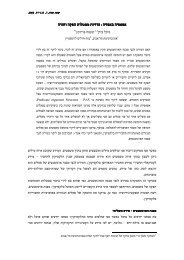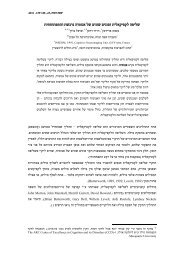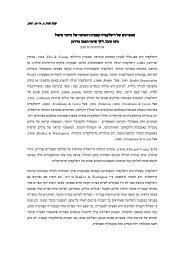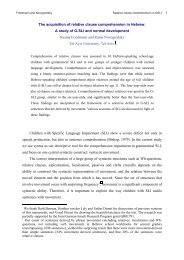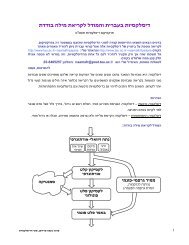Developmental surface dyslexias - Naama Friedmann
Developmental surface dyslexias - Naama Friedmann
Developmental surface dyslexias - Naama Friedmann
Create successful ePaper yourself
Turn your PDF publications into a flip-book with our unique Google optimized e-Paper software.
cortex 44 (2008) 1146–1160 1149<br />
grapheme-to-phoneme conversion, although some conversions<br />
might be favorable. Even 3-letter words might theoretically<br />
have several thousands of possible readings. For<br />
example, in the word , QBS, each of the three letters can<br />
be converted to either of two consonants, and the vowels<br />
are not represented, so after each consonant letter one of six<br />
vowels can be used. Together with the two possible stress positions,<br />
this leads to 2 2 2 6 6 6 2 ¼ 3456 theoretical<br />
ways to read this word, which the orthographic lexicon narrows<br />
down to three lexical options.<br />
Another result of this structure of Hebrew orthography that<br />
is important for the description of <strong>surface</strong> dyslexia is the abundance<br />
of potentiophones (Gvion and <strong>Friedmann</strong>, 2001; Lukov and<br />
<strong>Friedmann</strong>, 2006). We use the term potentiophones for word<br />
pairs that are written differently and sound differently, but<br />
whose letter sequence can be mapped onto the same sound<br />
string. Therefore when such a word is read solely via grapheme-to-phoneme<br />
conversion, it can be read aloud as the other<br />
existing word, which sounds differently. An example in English<br />
is the word now that can be read as no or know when read<br />
via grapheme-to-phoneme conversion (other examples for<br />
English potentiophones are resent–recent, come–comb, bear–<br />
beer, angle–angel, talk–talc, and whose–hose). Examples for<br />
potentiophones in Hebrew are the pairs (KtR–QTR,<br />
/katar/–/keter/, locomotive–crown), (QMO–KMO, /kmo/–/<br />
kamu/, like–woke up), and (XOL–XBL, /xol/–/xevel/, sand–<br />
rope).<br />
Potentiophones are valuable for the diagnosis of <strong>surface</strong><br />
dyslexia, because reading aloud of these words can already<br />
indicate whether or not the reader used her lexical route<br />
for reading. They are better for the detection of <strong>surface</strong> dyslexia<br />
than homophones, because homophones sound the<br />
same and thus reading aloud cannot indicate whether<br />
they were read correctly or not, and they thus require comprehension<br />
tasks. Furthermore, potentiophones might be<br />
more sensitive to <strong>surface</strong> dyslexia reading than other irregular<br />
words because the reading of irregular words that do<br />
not have potentiophones results in a nonlexical response.<br />
Because some individuals with <strong>surface</strong> dyslexia have<br />
a strong tendency to produce real words as output (Patterson<br />
et al., 1985, p. 12), this nonlexical response may be<br />
identified by the reader as incorrect, and corrected immediately<br />
in an attempt to reach a lexical response. An incorrect<br />
reading of a potentiophone, however, yields an existing<br />
word, and hence does not allow the detection of the<br />
error.<br />
In the current study we used these characteristics of Hebrew<br />
orthography to examine <strong>surface</strong> dyslexia, and more specifically<br />
three subtypes of developmental <strong>surface</strong> dyslexia. We<br />
also explored the way <strong>surface</strong> dyslexia is manifested in<br />
a highly irregular language like Hebrew.<br />
2. Experimental investigation<br />
2.1. Participants<br />
2.1.1. Participants with developmental <strong>surface</strong> dyslexia<br />
The participants with <strong>surface</strong> dyslexia were individuals who<br />
had developmental dyslexia, who were diagnosed with<br />
‘‘learning disabilities’’ or ‘‘reading disabilities’’ prior to the<br />
study. We included them in the study based on the number<br />
and types of errors they made in single word reading. Participants<br />
were included in the study only if their reading aloud<br />
(see Section 2.2.1) included significantly more errors than<br />
the control group, and the type of errors they made in reading<br />
were errors that result from reading via graphemeto-phoneme<br />
conversion: regularizations, errors in vowel<br />
pattern of unvoweled words or words with ambiguous vowel<br />
letters, and potentiophone errors. The comparison of each<br />
participant to her/his control group was done using the<br />
Crawford and Howell’s (1998) t-test for the comparison of<br />
a single participant to a group.<br />
This created a group of 17 participants, six female and<br />
11 male. Their background information is presented in<br />
Table 1. All the participants with developmental <strong>surface</strong><br />
dyslexia had normal IQ, and studied in regular schools<br />
and regular classes. They had normal language, their spontaneous<br />
speech was normal and none of them was diagnosed<br />
with SLI (specific language impairment). Four of the<br />
participants (TM, OM, BZ, and YD) were tested with spoken<br />
language test batteries for the diagnosis of syntactic impairments<br />
(BAMBI, <strong>Friedmann</strong> and Novogrodsky, 2002; BAFLA,<br />
<strong>Friedmann</strong>, 1998), and a test battery for the assessment of<br />
phonological abilities (BLIP, <strong>Friedmann</strong>, 2003), showing performance<br />
within the norm in syntax and phonology. In order<br />
to avoid <strong>surface</strong> dyslexia-like reading that resulted from<br />
lack of sufficient exposure to reading, we only included participants<br />
who were in fifth grade and higher, and who had<br />
effective classroom instruction. Eleven of the participants<br />
were in fifth or sixth grade, four were in middle school,<br />
and two were adults. All of them had Hebrew as their<br />
mother tongue, and one was bilingual and had both Hebrew<br />
and English as mother tongues. They had no hearing<br />
impairment, and none of them had a history of neurological<br />
disease or head trauma that might have led to acquired<br />
Table 1 – Background information on the participants<br />
with developmental <strong>surface</strong> dyslexia<br />
Participant Age Grade Gender Handedness Remedial<br />
teaching<br />
SH 10;8 5 M R Yes<br />
GL 10;10 5 F R –<br />
OF 11;2 5 M R –<br />
YR 11;0 5 M R Yes<br />
TM 12;0 6 F R Yes<br />
NT 12;8 6 M R Yes<br />
OM 14;10 8 M R Yes<br />
BZ 43 Adult M R –<br />
AS 11 5 M R Yes<br />
OS 11 5 F R –<br />
AK 13;9 8 M R Yes<br />
AM 10;7 5 F R –<br />
AL 11 5 M R Yes<br />
KR 11 5 F R –<br />
NF 14;5 8 M R Yes<br />
IR 15;10 9 M L Yes<br />
YD 21 Adult F R Yes




